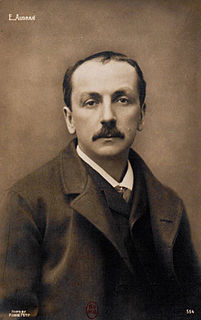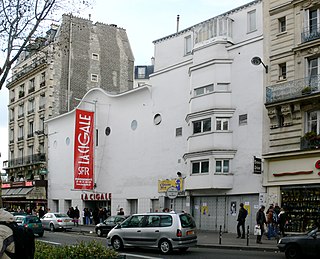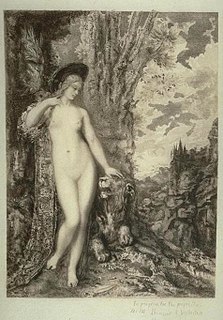This disambiguation page is currently linked from a large number of articles.(May 2021) (Learn how and when to remove this template message) |
Cigale or Cigales and La Cigale with the French definite article "la" may refer to:
This disambiguation page is currently linked from a large number of articles.(May 2021) (Learn how and when to remove this template message) |
Cigale or Cigales and La Cigale with the French definite article "la" may refer to:

Aesop's Fables, or the Aesopica, is a collection of fables credited to Aesop, a slave and storyteller believed to have lived in ancient Greece between 620 and 564 BCE. Of diverse origins, the stories associated with his name have descended to modern times through a number of sources and continue to be reinterpreted in different verbal registers and in popular as well as artistic media.

Ladislas Starevich was a Polish-Russian stop-motion animator notable as the author of the first puppet-animated film The Beautiful Leukanida (1912). He also used dead insects and other animals as protagonists of his films. Following the Russian Revolution, Starevich settled in France.

Auguste-Henri Forel was a Swiss myrmecologist, neuroanatomist, psychiatrist and eugenicist, notable for his investigations into the structure of the human brain and that of ants. For example, he is considered a co-founder of the neuron theory. Forel is also known for his early contributions to sexology and psychology. From 1978 until 2000 Forel's image appeared on the 1000 Swiss franc banknote.

Bernard Werber is a French science fiction writer, active since the 1990s. He is chiefly recognized for having written the trilogy Les Fourmis, the only one of his novels to have been published in English. This series weaves together philosophy, spirituality, science fiction, thriller, science, mythology and consciousness.

Maurice Charles Delage was a French composer and pianist.

Achille Edmond Audran was a French composer best known for several internationally successful comic operas, including Les noces d'Olivette (1879), La mascotte (1880), Gillette de Narbonne (1882), La cigale et la fourmi (1886), Miss Helyett (1890), and La poupée (1896).

The Ant and the Grasshopper, alternatively titled The Grasshopper and the Ant, is one of Aesop's Fables, numbered 373 in the Perry Index. The fable describes how a hungry grasshopper begs for food from an ant when winter comes and is refused. The situation sums up moral lessons about the virtues of hard work and planning for the future.

Cigale is a divertissement-ballet in two acts by Jules Massenet to a scenario by Henri Cain. It was first performed at the Opéra-Comique in Paris on 4 February 1904. The story it's inspired by the fable The Grasshopper and the Ant, but it's totally different. In this case the grasshopper being a cicada and the ant referred to only as "La Pauvrette". La Pauvrette, after being taken in, fed and fêted by La Cigale, is rude and heartless when the situation is reversed. Cigale is left to die in the snow at the close of the ballet. The music, recorded by conductor Richard Bonynge and available commercially, is astounding in its charm and vitality, if possibly outmoded for the date of composition. The ballet is rarely, if ever, revived and is not part of the standard ballet repertory.
Les Fourmis is a 1991 science fiction novel by French writer Bernard Werber. It was released in English as Empire of the Ants. The book sold more than two million copies and has been translated into more than 30 languages. It was also taken to video game format.

Henri Cain was a French dramatist, opera and ballet librettist. He wrote over forty librettos from 1893 to his death, for many of the most prominent composers of the Parisian Belle Epoque.

Jeanne Granier was a French soprano, born and died in Paris, whose career was centred on the French capital.

The mouse turned into a maid is an ancient fable of Indian origin that travelled westwards to Europe during the Middle Ages and also exists in the Far East. The story is Aarne-Thompson type 2031C in his list of cumulative tales, another example of which is The Husband of the Rat's Daughter. It concerns a search for a partner through a succession of more powerful forces, resolved only by choosing an equal.
Marcelle de Manziarly was a French pianist, music educator, conductor and composer. She was born in Kharkiv, studied in Paris with Nadia Boulanger and at the age of 23 had already composed two mature works. She later studied conducting with Felix Weingartner in Basle and piano with Isabelle Vengerova in New York City and taught and performed in Europe and the United States. Aaron Copland dedicated his song "Heart, We Will Forget Him" to her. She died in Ojai, California. Wrote a piece called Pour N.B as a dedication to her past teacher, Nadia Boulanger. The American premiere of this piece was sung by Tenor, Sam Mathis.

La Cigale is a theater at 120, boulevard de Rochechouart near Place Pigalle, in the 18th arrondissement of Paris. The theatre is part of a complex that is connected to Le Trabendo and the Boule Noire. The hall can accommodate 1389 people or 954 people. The floor of the orchestra has a scalable platform that can tilt and rise through a system of hydraulics.

Jean de La Fontaine collected fables from a wide variety of sources, both Western and Eastern, and adapted them into French free verse. They were issued under the general title of Fables in several volumes from 1668 to 1694 and are considered classics of French literature. Humorous, nuanced and ironical, they were originally aimed at adults but then entered the educational system and were required learning for school children.
The Old Man and Death is one of Aesop's Fables and is numbered 60 in the Perry Index. Because this was one of the comparatively rare fables featuring humans, it was the subject of many paintings, especially in France, where Jean de la Fontaine's adaptation had made it popular.

Les Animaux modèles, FP 111, is a ballet dating from 1940 to 1942 with music by Francis Poulenc. It was the third and final ballet that he composed and was staged at the Paris Opéra in 1942, with choreography by Serge Lifar, who also danced in the 1942 premiere. The themes of the ballet are drawn from the Fables of Jean de La Fontaine.

The Lion in Love is a cautionary tale of Greek origin which was counted among Aesop's Fables and is numbered 140 in the Perry Index. Its present title is a translation of the one given by Jean de la Fontaine after he retold it in his fables. Since then it has been treated frequently by artists. It has also acquired idiomatic force and as such has been used as the title of several literary works.
Robert Alphonse Collard, also known as Robert Lortac or simply Lortac, was a French writer, illustrator, portraitist and art critic. He is considered a pioneer in animation.

La cigale et la fourmi is a three-act opéra comique, with music by Edmond Audran and words by Henri Chivot and Alfred Duru. Loosely based on Jean de La Fontaine's version of Aesop's fable The Ant and the Grasshopper, the opera shows the lives of two young women, one prudent, like the ant, the other improvident and reckless, like the grasshopper. Unlike the Aesop fable this version has a happy ending, with the "ant" looking after the destitute "grasshopper".